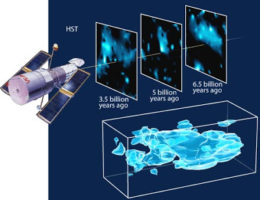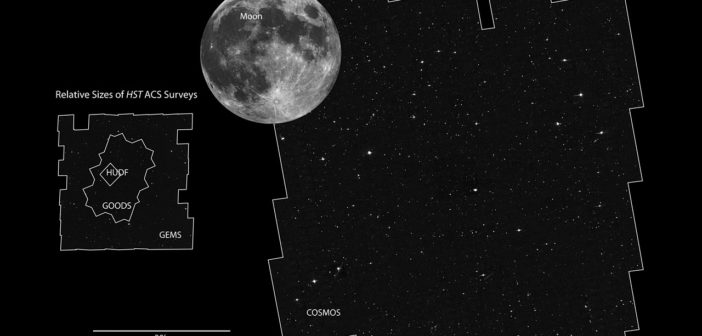Editor’s note: In these last two weeks of 2017, we’ll be looking at a few selections that we haven’t yet discussed on AAS Nova from among the most-downloaded papers published in AAS journals this year. The usual posting schedule will resume in January.
CANDELS Multi-Wavelength Catalogs: Source Identification and Photometry in the CANDELS COSMOS Survey Field
Published January 2017
Main takeaway:
A publication led by Hooshang Nayyeri (UC Irvine and UC Riverside) early this year details a catalog of sources built using the Cosmic Assembly Near-infrared Deep Extragalactic Legacy Survey (CANDELS), a survey carried out by cameras on board the Hubble Space Telescope. The catalog lists the properties of ~38,000 distant galaxies visible within the COSMOS field, a two-square-degree equatorial field explored in depth to answer cosmological questions.
Why it’s interesting:

Illustration showing the three-dimensional map of the dark matter distribution in the
COSMOS field. [Adapted from NASA/ESA/R. Massey
(California Institute of Technology)]
- Studying the most distant objects in the universe at the epoch of reionization in the cosmic dawn.
- Understanding galaxy formation and evolution during the peak epoch of star formation in the cosmic high noon.
- Studying star formation from deep ultraviolet observations and studying cosmology from supernova observations.
Why CANDELS is a major endeavor:
CANDELS is the largest multi-cycle treasury program ever approved on the Hubble Space Telescope — using over 900 orbits between 2010 and 2013 with two cameras on board the spacecraft to study galaxy formation and evolution throughout cosmic time. The CANDELS images are all publicly available, and the new catalog represents an enormous source of information about distant objects in our universe.
Citation
H. Nayyeri et al 2017 ApJS 228 7. doi:10.3847/1538-4365/228/1/7

1 Comment
Pingback: Selections from 2017: Hubble Survey Explores Distant Galaxies – MeasurementDataBases for Industry & Science